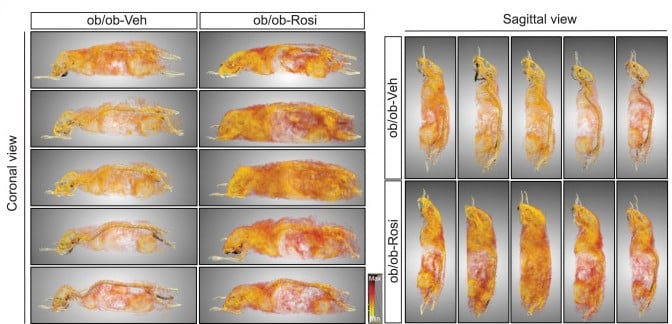Inside our bodies lies a complex system of fat tissue that does far more than just store excess energy. When functioning properly, fat tissue helps maintain normal blood sugar levels and overall metabolic health. But in obesity, this vital system can malfunction when fat cells become too large—and now UCLA scientists have discovered why.
Published in Cell Reports | Estimated reading time: 6 minutes
A team led by Dr. Claudio Villanueva at UCLA’s Eli and Edythe Broad Center of Regenerative Medicine and Stem Cell Research has identified a crucial molecular mechanism that explains why obesity causes fat cells to become enlarged rather than dividing to create new, smaller cells. The answer lies in fat stem cells’ inability to produce essential cellular building blocks called ribosomal factors.
“Fat tissue has gotten a bad rap, but it’s actually essential for maintaining normal glucose metabolism,” explains Dr. Villanueva. “What happens in obesity is that we have too much fat tissue and it’s also not functioning optimally.”
When fat cells become too large, they can’t properly store energy from food. This excess energy gets redirected to other parts of the body, potentially leading to fatty liver disease and cardiovascular problems. It’s like trying to stuff more clothes into an already overfilled closet—eventually, items start spilling out and causing problems elsewhere.
The research team discovered that in obese mice, fat cells were four to five times larger than those in lean mice. These enlarged cells resulted from fat stem cells lacking proper ribosomal factors, which prevented them from dividing and creating new, healthy fat cells.
But there’s hope. The scientists found that when obese mice were treated with a drug called rosiglitazone, their fat stem cells began producing normal levels of ribosomal factors again. This triggered the creation of new, smaller fat cells that could properly store and process energy.
Perhaps most intriguingly, the mice remained obese after treatment, but their Type 2 diabetes symptoms essentially disappeared. “It’s like replacing one overstuffed storage unit with several smaller ones – the system just works better,” Villanueva notes.
The discovery holds particular significance for communities disproportionately affected by obesity and diabetes. “I’m originally from Nicaragua,” shares Villanueva. “Latinos have a higher risk for developing obesity and Type 2 diabetes, so I’m hopeful this work will have a positive impact on my community.”
This research opens new pathways for developing treatments that could help fat tissue function better in people with obesity. By understanding exactly how fat cells grow and divide, scientists can work on therapies that encourage the creation of healthy new fat cells rather than allowing existing ones to become dangerously large.
Key Terms
- Ribosomal Factors
- Essential cellular components that help cells create new proteins and are necessary for proper cell division and function.
- Fat Stem Cells
- Special cells in fat tissue that can divide and develop into new fat cells when needed.
- Glucose Metabolism
- The process by which the body processes sugar (glucose) for energy and maintains healthy blood sugar levels.
Test Your Knowledge
Why is having enlarged fat cells problematic?
Enlarged fat cells can’t properly store energy, causing excess energy to be redirected to other organs like the liver and heart, potentially leading to disease.
What role do ribosomal factors play in fat tissue health?
Ribosomal factors are essential for fat stem cells to divide and create new, healthy fat cells. Without them, existing fat cells become enlarged instead of dividing.
How did the treatment affect the obese mice?
While the mice remained obese, their Type 2 diabetes symptoms essentially disappeared because their fat tissue began functioning properly with smaller, healthier fat cells.
Why is this research particularly significant for certain communities?
Some communities, such as Latinos, have higher risks for developing obesity and Type 2 diabetes, making this research especially relevant for developing targeted treatments.
Enjoy this story? Subscribe to our newsletter at scienceblog.substack.com


